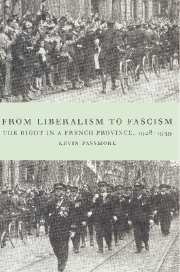Book contents
- Frontmatter
- Contents
- List of illustrations
- Preface
- List of abbreviations
- 1 Introduction
- 2 From France to the Rhône
- 3 Urban society in the Rhône
- 4 Rural society in the Rhône
- 5 The crisis of the right I: 1928–1932
- 6 The impact of the economic crisis
- 7 The crisis of the right II: 1932–June 1936
- 8 The Croix de Feu
- 9 The right and the Popular Front
- 10 Conclusion
- Appendix 1 Equations for multiple regressions
- Appendix 2 The conservative deputies of the Rhône, 1928–1940
- Select bibliography
- Index
4 - Rural society in the Rhône
Published online by Cambridge University Press: 23 December 2009
- Frontmatter
- Contents
- List of illustrations
- Preface
- List of abbreviations
- 1 Introduction
- 2 From France to the Rhône
- 3 Urban society in the Rhône
- 4 Rural society in the Rhône
- 5 The crisis of the right I: 1928–1932
- 6 The impact of the economic crisis
- 7 The crisis of the right II: 1932–June 1936
- 8 The Croix de Feu
- 9 The right and the Popular Front
- 10 Conclusion
- Appendix 1 Equations for multiple regressions
- Appendix 2 The conservative deputies of the Rhône, 1928–1940
- Select bibliography
- Index
Summary
A relatively insignificant 18% of the population of the Rhône lived in communes defined as rural; 64,000 economically active persons were occupied in agriculture. The figures confirm the predominantly urban and industrial nature of the department. Yet because of the advantage that conservative parties drew from overrepresentation in elected bodies, the rural world cannot be neglected. During the Belle époque the peasantry had provided much of the electoral backing for the wealthy notables who represented Progressisme in Parliament. But this did not mean that peasants had been incorporated into an ‘hegemonic bloc’. Support among the peasantry was conditional, while in many areas the rural elites remained suspicious of Progressisme. First, in the Monts du Lyonnais and the Beaujolais voters backed the Progressistes in legislative elections only because the arrangement of constituency boundaries submerged the antirepublican minority. In both areas many wealthy aristocratic or bourgeois Catholic notables retained a hankering after monarchy. In the Lyonnais mountains they relied on the influence of the Church over isolated peasants. In the Beaujolais they depended on the ties of landowner and sharecropper as well as on the Church. Second, in the Beaujolais mountains, peasants were equally isolated and open to clerical influence. But here moderate republican industrialists were more powerful than nobles. So an elite-dominated Progressisme flourished, again with the tacit support of the Church. Thirdly, on the plateau there existed a peasant conservatism based on Catholicism, prosperity, market opportunity and loyalty to Progressiste notables. During the interwar period, in all three areas, the leadership of notables, whatever their political colour, was called into question, just as the position of the liberal elite had been undermined in urban society.
- Type
- Chapter
- Information
- From Liberalism to FascismThe Right in a French Province, 1928–1939, pp. 90 - 115Publisher: Cambridge University PressPrint publication year: 1997

